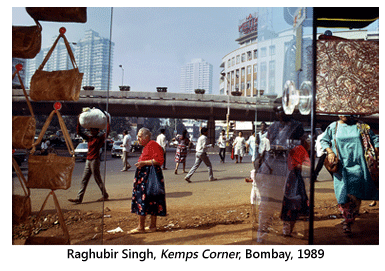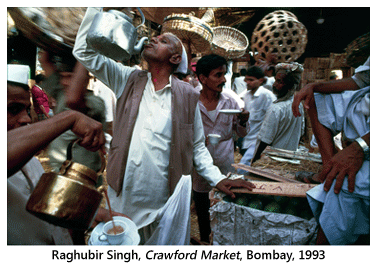- Prelude
- Editorial
- Raghu Rai: The Historian
- Ryan Lobo, 34 in Baghdad
- Through the Eye of a Lensman
- Adrian Fisk
- And Quiet Flows the River
- The Lady in the Rough Crowd: Archiving India with Homai Vyarawalla
- Raja Deen Dayal:: Glimpses into his Life and Work
- Raja Deen Dayal (1844-1905) Background
- Vintage Views of India by Bourne & Shepherd
- The Outsiders
- Kenduli Baul Mela, 2008
- Collecting Photography in an International Context
- Critical Perspectives on Photograph(y)
- The Alkazi Collection of Photography: Archiving and Exhibiting Visual Histories
- Looking Back at Tasveer's Fifth Season
- Kodachrome: A Photography Icon
- Three Dreams or Three Nations? 150 Years of Photography in India, Pakistan and Bangladesh
- Show And Tell – Exploring Contemporary Photographic Practice through PIX
- Vintage Cameras
- Photo Synthesis
- The Right Way to Invest
- What Happened and What's Forthcoming
- Art Events Kolkata: March – April 2011
- Art Bengaluru
- Mumbai Art Sighting
- North East Opsis
- Previews
- In the News
- Somnath Hore
ART news & views
Kodachrome: A Photography Icon
Volume: 3 Issue No: 16 Month: 5 Year: 2011
by Sujoy Das
“Kodachrome
You give us those nice bright colors
You give us the greens of summers
Makes you think all the world's a sunny day, oh yeah!
I got a Nikon camera
I love to take a photograph
So Mama, don't take my Kodachrome away”
Paul Simon, Kodachrome, 1973

On 31st December 2010 a long line of photographers stood in front of Dwayne Photos in Parsons, Kansas (USA), clutching red and yellow film cartons in their hands. The photographers seemed to be a subdued lot talking in hushed tones and waiting for their turn to enter the laboratory. And as the last photographer entered and handed over his film to Dwayne, the curtain fell on one of the most iconic brands in the history of photography – Kodachrome.
On 22nd June 2009 after 74 years in production, Eastman Kodak, Rochester announced the demise of Kodachrome and Dwayne Photos became the only laboratory in the world to continue to process the film upto 31st December 2011.
One could well ask what was so special about Kodachrome when in the last ten years or so, more and more photographers have embraced digital technology and the demise of film in general is considered a long foregone conclusion?
As a photographer I have not used Kodachrome in the last fifteen years, but when I first started out, that was my film of choice. More recently, I was expecting the withdrawal of this film from the market for some time. Yet, when it finally happened, it was like a hard punch in the solar plexus.  It was almost as though an old friend had passed without a trace. Photographers all over the world, for over 75 years now, have remained fiercely loyal to this film. Why?
It was almost as though an old friend had passed without a trace. Photographers all over the world, for over 75 years now, have remained fiercely loyal to this film. Why?
The super fine grain, rich hues, the subtlety of colours, life-like textures, and archival durability all represent the varied hallmark characteristics of Kodachrome as a professional choice of film. For years it was the flagship to which all other films were compared. I remember the universal refrain from photographers when looking at images from other slide films. “Not like Kodachrome”, they would say.
It was processed with a technology called K-14 which was the odd one out in the long list of standard slide films all processed under E6. Perhaps this was another contributing factor that further hastened its demise. It was just too specialized, but perhaps that should be something to strive for. On hearing of the imminent demise of Kodachrome, American photographer Daniel Bayer started what he called “The Kodachrome Project”. In the last quarter of 2010, Bayer crisscrossed the continent and shot around 600 rolls of the film which will feature in a book.
We can see that the lure of Kodachrome still continues. The film regularly appears on Ebay and other internet auction sites and is lapped by up photographers for premium rates. Quite amazing that a film started by Eastman Kodak in 1931 has finally become a collector's item!

Interestingly, Kodachrome film also had a very special smell which no other film had. I remember eagerly opening the yellow boxes and holding the film close and breathing in deeply. Odd as this might seem, many other photographers would have shared a similar experience.
As the years went by, more and more laboratories stopped processing Kodachrome. For instance, In India, Kodak Bombay stopped the process sometime in the late 80s. I remember shooting Kodachrome for a critical assignment in Sikkim and sending the film by courier to a Kodak lab in Lausanne, Switzerland of all places. I was anxiously waiting for the film to return and when it finally did, I remember opening the yellow Kodak slide boxes, loading up the slide projector and watching with amazement as the vibrant colours splashed four feet by six feet across a wall. It was a memorable experience which in itself, to my mind cannot be matched by any form of digital technology today. As the years went by and Kodachrome became more and more difficult to find, diehard believers in the film were left with no option but to use new technology that was easier to process – E6 slide films like Fuji Velvia, Provia and Kodak's own Ektachrome.
Steve McCurry, the renowned National Geographic photographer, also shot Kodachrome for many years. His famous photograph of the Afghan girl was taken on Kodachrome in the 80s. Interestingly, when McCurry went back sixteen years later to shoot her again, he used Ektachrome Professional, a later and more advanced offering from Kodak. Technologically, Kodachrome was being challenged by its own creator. Finally, the last roll of Kodachrome to be manufactured by Eastman Kodak, Rochester was given to McCurry for his shoot covering India, USA, Middle East and Europe. It is soon to feature in a National Geographic story, that primarily traces the life of this great film.
Closer to home, the late Raghubir Singh's evocative photographs on Calcutta published in the late sixties were also shot on Kodachrome. While shooting the Ganga, he made an awe inspiring image of Swami  Shradhanand bathing at Goumukh at dawn against the backdrop of the Bhagirathi peaks which was a product of this amazing emulsion.
Shradhanand bathing at Goumukh at dawn against the backdrop of the Bhagirathi peaks which was a product of this amazing emulsion.
Most photographers who were Kodachrome fans would agree that having that particular film in the camera definitely boosted both morale and confidence. It was reassuring and comforting. Stepping out to shoot with Kodachrome, we used to say “Now that you have Kodachrome your worries are over, expose correctly and let the film do the rest!”
Award winning photographer Eric Meola sums this up beautifully when he says:
“There are in life a few constants, but far too few. The sun rises in the morning and sets at night, and Kodachrome was what was always there to help us record those sunrises and sunsets and to brilliantly capture that ephemeral distance between light and shadow. We waited up nights to open those golden boxes--like young children surprised with glee and knowing we could drift asleep again and that all was right with the world, and that there was still Kodachrome, and almost nothing else mattered."
© Succession Raghubir Singh | Images Courtesy: Sujoy Das | © Succession Raghubir Singh